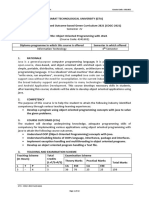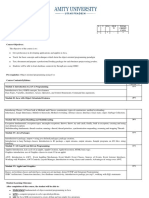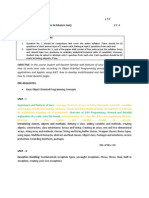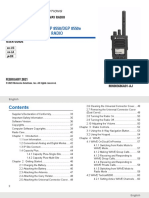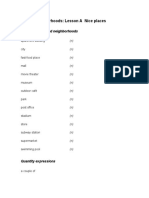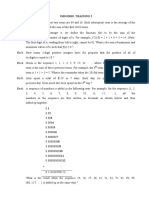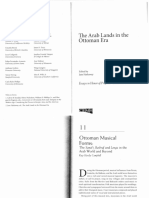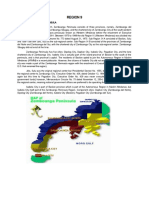COURSE TITLE : JAVA PROGRAMMING COURSE CODE:CM41205
GOVERNMENT POLYTECHNIC, PUNE
‘120 – NEP’ SCHEME
PROGRAMME DIPLOMA IN CM
PROGRAMME CODE 06
COURSE TITLE JAVA PROGRAMMING
COURSE CODE CM41205
PREREQUISITE COURSE CODE & TITLE NA
CLASS DECLARATION YES
I. LEARNING & ASSESSMENT SCHEME
Learning Scheme Assessment Scheme
Actual
Based on LL &
Cou Contact Theory Based on
Credits TSL
rse Hrs./Week SL
Course Course Title Paper Total
Typ SLH NLH Practical
Code Duration Marks
e FA- SA-
CL TL LL Total FA-PR SA-PR SLA
TH TH
Max Max Max Min Max Min Max Min Max Min
CM41205 JAVA DSC 3 1 2 - 6 3 3 Hrs 70 30 100 40 25 10 25# 10 - - 150
PROGRAMMING
Total IKS Hrs for Term: 0 Hrs
Abbreviations: CL-Classroom Learning, TL-Tutorial Learning, LL-Laboratory Learning, SLH-Self Learning Hours, NLH-
Notional Learning Hours, FA - Formative Assessment, SA -Summative assessment, IKS – Indian Knowledge System, SLA- Self
Learning Assessment
Legends: @-Internal Assessment, # - External Assessment,*# - Online Examination,@$ - Internal Online Examination
Note:
FA-TH represents an average of two class tests of 30 marks each conducted during the semester.
1. If a candidate is not securing minimum passing marks in FA-PR (Formative Assessment - Practical) of any course,
then the candidate shall be declared as 'Detained' in that course.
2. If a candidate does not secure minimum passing marks in SLA (Self Learning Assessment) of any course, then the candidate
shall be declared as 'fail' and will have to repeat and resubmit SLA work.
3. Notional learning hours for the semester are (CL + LL + TL + SL) hrs. * 15 Weeks
4. 1 credit is equivalent to 30 Notional hours.
5. * Self-learning hours shall not be reflected in the Timetable.
6.* Self-learning includes micro-projects/assignments/other activities.
II. RATIONALE:
Java is a widely used, platform-independent, and open-source object-oriented programming language.
With strong industry support and a rich ecosystem of free libraries, it underpins technologies like Advanced
Java, JSP, and Android development. This course equips Computer Engineering and IT students with essential
and advanced Java skills through hands-on practice, preparing them for real-world software development and
boosting their employability.
III. COURSE-LEVEL LEARNING OUTCOMES (CO'S)
Students will be able to achieve & demonstrate the following CO's on completion of course-based learning
CO1 - Apply object-oriented programming concepts by developing Java programs using classes and objects.
CO2 – Apply inheritance and interfaces in java to achieve code reusability
CO3 - Develop Java program implementing multithreading and exception handling.
CO4 - Implement event-driven programming in Java using appropriate event handling mechanisms.
CO5 - Develop client-server applications using Java network programming concepts.
CO6 – Implement Java applications using JDBC for effective database connectivity and management.
GOVT. POLYTECHNIC, PUNE. Page 1
COURSE TITLE : JAVA PROGRAMMING COURSE CODE:CM41205
IV. THEORY LEARNING OUTCOMES AND ALIGNED COURSE CONTENT
Suggested
Sr. Theory Learning Outcomes Learning content mapped with TLO's. Relevant
(TLO'S) aligned to CO's. Learning
No COs
Pedagogies
SECTION-I
UNIT-I BASICS OF JAVA (CL Hrs-6, Marks-11 )
TLO 1.1 Write programs to 1.1 Java features and the Java programming
create classes and objects for the environment
given problem. 1.2 Defining a class, creating object,
TLO 1.2 Describe characteristics accessing class members
of the given java token. 1.3 Java tokens and data types, symbolic
TLO1.3 Write program to constant, scope of variable, typecasting,
evaluate given expressions. and different types of operators and
TLO 1.4 Write programs using expressions, decision making and
Hands-on
relevant control structure to solve looping statements
1. Demonstration CO1
the given problem. 1.4 Arrays, strings, string buffer classes,
Presentations
TLO 1.5 Develop programs using vectors, wrapper classes
vectors and wrapper classes for 1.5 Constructors and methods, types of
the given problem. constructors, method and constructor
TLO 1.6 Use constructors for the overloading, nesting of methods,
given programming problem command line arguments, garbage
collection, visibility control: public,
private, protected, default, private
protected.
UNIT-II INHERITANCE,INTERFACE AND PACKAGES (CL Hrs-6, Marks-12 )
TLO 2.1 Apply identified type 2.1 Inheritance: concept of inheritance,
of inheritance for the given types of Inheritance: single inheritance,
programming problem. multilevel inheritance, hierarchical
TLO 2.2 Differentiate between inheritance, method overriding, final
overloading and overriding with variables, final methods, use of super,
the help of examples. abstract methods and classes
TLO 2.3 Develop program using 2.2 Interfaces: Define interface, Hands-on
2 interface. implementing interface, accessing Demonstration CO2
TLO 2.4 Create user defined interface variables and methods, Presentations
package for the given problem. extending interfaces
2.3 Package: Define package, types of
package, naming and creating package,
accessing package, import statement,
static import, adding class and
interfaces to a package
UNIT-III EXCEPTION HANDLING AND MULTITHREADING (CL Hrs-8, Marks-12)
TLO 3.1 Distinguish the errors 3.1 Errors and Exception: Types of errors
and exceptions with example. and exceptions try and catch statement,
TLO 3.2 Develop program for throws and finally statement, built-in Hands-on
handling the given exception. exceptions, throwing our own Demonstration CO3
3 TLO 3.3 Create threads to run exception. Presentations
multiple processes in a program. 3.2 Multithreaded programming: creating a
TLO 3.4 Develop program using thread: By extending to thread class and
GOVT. POLYTECHNIC, PUNE. Page 2
COURSE TITLE : JAVA PROGRAMMING COURSE CODE:CM41205
different thread life cycle by implementing runnable Interface,
methods. Life cycle of thread: Thread methods,
thread exceptions, thread priority and
methods, synchronization.
SECTION-II
UNIT- IV EVENT HANDLING USING AWT AND SWING COMPONENTS (CL Hrs-13, Marks-15)
TLO 4.1 Write steps to develop 4.1 AWT:Component, Container, Window,
Graphical User Interface (GUI) Frame, Panel, Applet, use of AWT
using AWT components with controls: Labels, Buttons, Checkbox,
frame for the given problem. Checkboxgroup, Textfield,
TLO4.2 Develop program using Textarea,List,Choice
menu and dialog boxes for the 4.2 Layout Managers: FlowLayout,
given problem. BorderLayout,GridLayout,CardLayout, Hands-on
TLO 4.3 Write steps to develop Menubars, Menus, Filedialog, Demonstration
Graphical user interface (GUI) Dialogbox Presentations
using advanced swing 4.3 Swing: Swing features, AWT vs Swing,
components for the given Swing components: Icons and Labels,
problem. TextField, ComboBox, Button, CO4
4 TLO 4.4 Use delegation event Checkbox, RadioButton , Tabbed
model to develop event driven Panes, Scroll Panes, Trees, Tables,
program for the given problem. Progress bar, Tooltip
TLO 4.5 Use relevant AWT/ 4.4 Event Handling: Event delegation
Swing component(s) to handle Model, MVC architecture
the given event. 4.5 Event classes: ActionEvent, ItemEvent
, KeyEvent, MouseEvent, TextEvent
4.6 Event Interfaces: ActionListener,
ItemListener, KeyListener,
MouseListener, MouseMotion,
TextListener
UNIT –V BASICS OF NETWORK PROGRAMMING(CL Hrs-6, Marks-12)
TLO 5.1 Describe the concepts 5.1 Networking Basics : Client/Server ,
of sockets in java. reserved Sockets , proxy servers ,
TLO 5.2 Use networking classes Internet Addressing
to retrieve host details. 5.2 InetAddress : Factory Methods ,
Hands-on
TLO 5.3 Develop program for Instance Methods
Demonstration CO5
5 Client/Server communication 5.3 TCP/IP :Socket and Server Socket class
Presentations
through TCP/IP Server sockets 5.4 UDP: DatagramSocket,
for the given problem DatagramPacket class
5.5 URL Class
5.6 URLConnection class
UNIT –VI INTERACTING WITH DATABASE (CL Hrs-6, Marks-8)
TLO 6.1 Choose relevant 6.1 Introduction to JDBC, ODBC
database connectivity methods. 6.2 JDBC architecture: Two tier and three
TLO 6.2 Describe two tier and tier models
Hands-on
three tier architecture of JDBC. 6.3 Types of JDBC drivers, Class Class ,
6 Demonstration CO6
TLO 6.3 Choose relevant type of DriverManager class, Connection
Presentations
JDBC driver for the specified interface, Statement interface,
environment. PreparedStatement interface, ResultSet
TLO 6.4 Elaborate steps with Interface
GOVT. POLYTECHNIC, PUNE. Page 3
COURSE TITLE : JAVA PROGRAMMING COURSE CODE:CM41205
example to establish connectivity
with the specified database.
V. LABORATORY LEARNING OUTCOME AND ALIGNED PRACTICAL/ TUTORIAL
EXPERIENCES.
Sr. Practical/Tutorial/Laboratory Laboratory Experiment/ Practical Titles Number Relevant
No Learning Outcome (LLO) /Tutorial Titles of hrs. COs
LLO 1.1 Implement conditional Demonstrate the use of conditional statements
1. statements
1 and control structures. and control structures. 4 CO1
2. LLO 2.1 Implement the use of a) Write a program to demonstrate one-
arrays and dynamic arrays using dimensional and two-dimensional array.
2 CO1
Vector to store and process data b) Use Vector class to perform dynamic array
elements. operations.
3. LLO 3.1 Demonstrate the use of Convert primitive data types into objects and
wrapper classes to convert primitive vice versa using wrapper classes like Integer,
2 CO1
types to objects and vice versa for Double, etc.
data encapsulation.
4. LLO 4.1 Apply the concepts of Implement single inheritance and multilevel
single and multilevel inheritance to inheritance with method overriding.
2 CO2
promote code reuse and logical
hierarchy.
5. LLO 5.1 Implement interfaces to Write a program to implement interfaces and
achieve abstraction and multiple multiple inheritance using interfaces. 2 CO2
inheritance in Java.
6. LLO 6.1 Use built-in and user- Demonstrate use of built-in packages (java.util,
defined packages for modular, java.io, etc.) and create user-defined packages.
2 CO2
maintainable Java program
development.
7. LLO 7.1 Implement robust Implement try, catch, finally, throw, and
exception handling using try, catch, throws for exception management.
2 CO3
finally, throw, and throws clauses to
manage errors.
8. LLO 8.1 Demonstrate Write a program to implement multithreading
multithreading using the Thread using Thread class and Runnable interface.
class and Runnable interface to 2 CO3
achieve parallelism in Java
applications.
9. LLO 9.1 Design interactive a) Create a form using AWT components like
graphical interfaces using AWT TextField, Label, and Button.
2 CO4
components to collect user input b) Write a program to implement Layout
and display output. Manager.
10. LLO 10.1 Build advanced GUIs a) Implement swing component’s JTree and
using Swing components. JTable.
LLO 10.2 Implement event-driven b) Handle KeyEvent, MouseEvent, 4 CO4
programming by handling user ActionEvent and TextEvent
actions such as key presses, mouse
GOVT. POLYTECHNIC, PUNE. Page 4
COURSE TITLE : JAVA PROGRAMMING COURSE CODE:CM41205
clicks, and button events in GUI
applications.
11. LLO 11.1 Implement Java a)Retrieve hostname and IP using InetAddress.
networking using InetAddress, b)Demonstrate use of URL and
URL, Socket, and Datagram classes URLConnection. 2 CO5
to facilitate client-server c) Implement socket communication (TCP)
communication. and datagram (UDP).
12. a) Create a sample database and connect using
LLO 12.1 Perform database
JDBC.
operations including connection,
b) Perform Insert, Update, Delete operations. 4 CO6
insertion, update, deletion, and data
c) Retrieve data using ResultSet and
retrieval using JDBC and ResultSet
demonstrate cursor navigation methods.
13. ALL
4 Micro-project (Refer section V for micro
- ALL
project list)
Note: Out of the above suggestive LLOs –
1. '*' Marked Practical’s (LLOs) are mandatory.
2. A judicial mix of LLOs is to be performed to achieve the desired outcomes
VI. SUGGESTED MICRO PROJECT/ASSIGNMENT/ACTIVITIES/CASE STUDIES FOR
SPECIFIC LEARNING/SKILLS DEVELOPMENT
Suggestive Micro Project Topics:
a) Develop Online Voting System: Role-based login (admin/voter), vote casting and result generation
with GUI and JDBC. Use exception handling for security.
b) Develop Fitness Tracker Application: Input daily workouts, calories burned, and track progress over
time. GUI input, JDBC storage, background threads for stats.
c) Develop Simple Blog Platform: Post, edit, delete blog posts. Login with roles (admin/user), GUI editor,
and data stored via JDBC. Add timestamp via threads.
d) Develop IoT Device Monitor Simulator: Simulate multiple smart devices using multithreading. Display
statuses in real-time via GUI, with data fetched/sent via sockets.
e) Develop Smart To-Do List: Add, update, delete tasks. Use OOP for task management, GUI for
interaction, JDBC for persistence, and threading for reminders.
f) Any other micro project as suggested by course teacher.
Assignments
Solve assignment covering all COs given by course teacher.
VII. LABORATORY EQUIPMENT/INSTRUMENTS/TOOLS/SOFTWARE REQUIRED
Relevant LLO
Sr.No Equipment Name with Broad Specifications
Number
a) Computer System with all necessary Peripherals and Internet connectivity.
1
b) Computer with JDK1.8 or above, any IDE for Java Programming such as
ALL
Eclipse, Jcreator, NetBeans,VScode .
c) Databases like MySQL, Oracle, MS-Access or any other.
GOVT. POLYTECHNIC, PUNE. Page 5
COURSE TITLE : JAVA PROGRAMMING COURSE CODE:CM41205
VIII. SUGGESTED FOR WEIGHTAGE TO LEARNING EFFORTS & ASSESSMENT PURPOSE
(Specification Table)
Sr. No Unit Unit Title Aligned COs Learning R-Level U-Level A-Level Total Marks
Hours
SECTION I
1 I Basics of JAVA CO1 06 03 04 04 11
2 II Inheritance, Interface and
CO2 06 02 04 06 12
Packages
3 III Exception Handling and
CO3 08 02 04 06 12
Multithreading
SECTION II
4 IV Event Handling using AWT
CO4 13 05 04 06 15
and Swing Components
5 V Basics of Network
CO5 06 02 04 06 12
Programming
6 VI Interacting with database CO6 06 02 02 04 08
Grand Total 45 16 22 32 70
IX. ASSESSMENT METHODOLOGIES/TOOLS
Formative assessment Summative Assessment
(Assessment for Learning) (Assessment of Learning)
Lab performance, Assignment, Self-learning and Lab. Performance, viva voce
Seminar/Presentation
X. SUGGESTED COS- POS MATRIX FORM
Programme
Programme Outcomes(Pos) Specific
Outcomes
Course *(PSOs)
Outcome PO-1 PO-2 PO-3 PO-4 PO-5 PO-6 Project PO-7 PSO-1 PSO-2
s (Cos) Basic and Problem Design/ Engineering Engineering Management Life
Discipline- Analysis Development Tools Practices for Long
Specific of Solutions Society, Learning
Knowledge Sustainability and
Environment
CO1 2 3 2 3 1 1 2 - 3
CO2 2 3 2 3 1 1 2 - 3
CO3 2 3 3 3 1 1 2 - 3
CO4 2 3 2 3 1 1 2 - 3
CO5 2 3 3 3 1 2 3 - 3
CO6 2 3 3 3 1 2 3 - 3
Legends:- High:03, Medium:02, Low:01, No Mapping: -
*PSOs are to be formulated at the institute level
GOVT. POLYTECHNIC, PUNE. Page 6
COURSE TITLE : JAVA PROGRAMMING COURSE CODE:CM41205
XI. SUGGESTED LEARNING MATERIALS/BOOKS
Sr.No Author Title Publisher
Schildt Herbert Java Complete Reference Mcgraw Hill Education, New Delhi .
1
ISBN:9789339212094
E Balaguruswamy Programming with JAVA Mcgraw Hill Education (India) Private Limited,
2
New Delhi . ISBN-13: 978-93-5134-320- 2
Holzner, Steven Java 8 Programming Black Dreamtech Press, New Delhi. ISBN: 978-93-
3
Book 5119-758-4
XII. LEARNING WEBSITES & PORTALS
1. https://www.javatpoint.com/java-tutorial
2. https://infyspringboard.onwingspan.com/web/en/app/toc/lex_29 959473947367270000_shared/overview
3. https://www.javatpoint.com/java-tutorial
4. https://www.w3schools.com/java/
5. https://www.tutorialspoint.com/java
Name & Signature:
Mrs. Swati S. Sant Mrs. Sonali B. Gosavi
Lecturer in Computer Engineering Lecturer in Computer Engineering
(Course Experts)
Name & Signature: Name & Signature:
Smt.Jyoti.R.Hange Shri. S.B. Kulkarni
(Programme Head) (CDC In-charge)
GOVT. POLYTECHNIC, PUNE. Page 7








